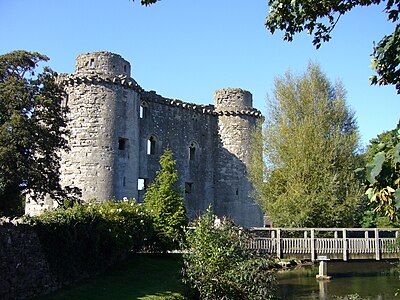Selected picture 1
Portal:Somerset/Selected picture/1

Credit: User:MichaelMaggs
Pulteney Bridge is a bridge that crosses the River Avon, in Bath. It was completed in 1773 and is designated as a grade I listed building.
Selected picture 2
Portal:Somerset/Selected picture/2

Credit: User:Stuz
Selected picture 3
Portal:Somerset/Selected picture/3

Credit: User:Arpingstone
The Roman Baths complex is a well-preserved Roman site for public bathing in the city of Bath next to the Perpendicular Gothic architecture of Bath Abbey.
Selected picture 4
Portal:Somerset/Selected picture/4
The Yarn Market in Dunster was built around 1590 and has been desinated as a Grade I listed building and scheduled ancient monument. One of the roof beams has a hole in it, a result of cannon fire in the Civil War.
Selected picture 5
Portal:Somerset/Selected picture/5
Clevedon Pier is a seaside pier in the town of Clevedon, on the English side of the Severn Estuary. It was built in the 1860s, and – after a partial collapse in the previous decade – was fully restored in the 1980s.
Selected picture 6
Portal:Somerset/Selected picture/6
The Abbot's Fish House in Meare, was built in the 14th century and has been designated as a Grade I listed building and Scheduled Ancient Monument. It was once the abode of the chief fisherman of Glastonbury Abbey and was used for salting and preparing fish. The fish were caught in Meare Pool which has since been drained. It is the only surviving monastic fishery building in England.
Selected picture 7
Portal:Somerset/Selected picture/7
Nunney Castle in the village of Nunney is a small, French-style castle surrounded by a deep moat, built for Sir John Delamare in 1373. During the English Civil Wars it was damaged by cannon fire. It was never lived in again. Today the moat, walls, and towers are still intact, but the floors and roof have been destroyed. The castle is currently managed by English Heritage, and is a Scheduled Ancient Monument.
Selected picture 8
Portal:Somerset/Selected picture/8
King John's Hunting Lodge is a wool-merchant's house of around 1500 in Axbridge. The property is run by the National Trust as a local history museum by Axbridge and District Museum Trust, in co-operation with Sedgemoor District Council, Somerset County Museums Service and Axbridge Archaeological and Local History Society. It is a Grade II* listed building.
Selected picture 9
Portal:Somerset/Selected picture/9
The West Country Carnival is an annual celebration featuring a parade of illuminated floats (termed "carts" locally). The celebration dates back to the Gunpowder Plot of 1605. The series of parades in each town now form a major regional festival. The event's purpose, as it has always been from the start, is to raise thousands of pounds for local charities from money collection carts in the two hour procession.





